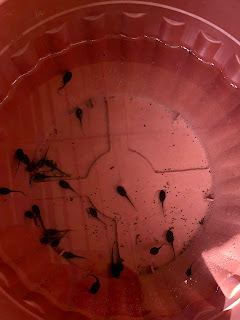 |
| Fresh Harvest of Cherry Tomatoes |
We had a lot of rain in the last 30 days. 8-10 inches in fact. My gardening friend quoted "17 inches in 16 days" so results vary. The good or the bad part of it, depending on your perspective, is most of the rain would fall overnight. There was no progress made on indoor projects. I remained outdoors mucking around wet grass and picking over-plump tomatoes.
 |
| Eggplant with Garlic Sauce |
Vegetables
Tomatoes were splitting with the excessive rain, but mostly edible. I harvested a nice bunch of eggplant to make my eggplant with garlic side dish. The eggplants are small, about 6 inches long, but I'm happy to have them. It looks like another group will be ready for a September harvest. |
| Tomato Harvest |
 |
| Tomato and Eggplant Garden |
 |
| Tomato Plants |
The jalapeños are plentiful. My summer's first serving of jalapeno poppers were so intensely hot, however, it scared us away from one of our favorite dishes.
Pests
 |
| Hornworm Eating Green Tomato |
There was an uptick in hornworm and other caterpillar activity on the tomatoes. This is a challenging game of trying to spot the very well-camouflaged worm on the plant. Clues are a stripped stem or a chewed green tomato (see photo) or waste material on leaves.
 |
| False Dragonhead Flower |
Flowers in bloom
The late summer flowers are starting to bloom now. A couple of days ago, the first False Dragonhead bloomed. When several of these bloom together, the color impact of the purple is amazing.
The flowers on the Crape Myrtle tree are a deep pink or fuchsia color. The tree has been allowed to grow tall so that the blooms are at the second story windows. Cleomes have finished blooming and I've collected seeds.
 |
| American Beautyberry |
The American Beautyberry is known more for its purple berries than flowers. The green berries are starting to change to a dramatic purple.
Coming Up Everywhere
Wind and birds have reseeded several plants across the yard. Lemon Balm, Crape Myrtle, and American Beautyberry plants are popping up everywhere.
☔
I hope you are having a great August! You can find rainfall totals for U.S. locations here.











































